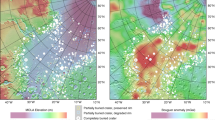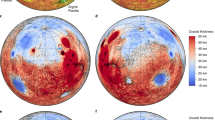Abstract
The early impact bombardment of Mars has been linked to the bombardment history of the inner Solar System as a whole. However, the timing and number of basin-forming impacts on Mars are poorly constrained. The Borealis basin—thought to be the largest and oldest known Martian impact basin—forms the crustal dichotomy between the northern lowlands and southern highlands. Four unambiguous large basins post-dating Borealis have been identified, but as many as 32 additional basins larger than 1,000 km in diameter have been proposed. Here we use gravity and topography analyses to show that the crustal dichotomy boundary was excavated by only one later impact basin (Isidis), which probabilistically indicates that fewer than 12 large basins across the globe could post-date the boundary and pre-date the established younger basins. Moreover, the relatively pristine topography and crustal thickness at the dichotomy boundary indicates that younger basins should be similarly well preserved. This suggests that the post-Borealis large basin population is limited to only the four known younger basins, with estimated ages between 3.8 and 4.1 Gyr ago (Ga). We present geochemical arguments that Borealis dates to near 4.5 Ga. Combined with Monte Carlo simulations, we argue that, instead of a gradually declining impactor flux, a lull in large basin-forming impacts occurred between about 4.1 and 4.4 Ga on Mars, separating the endgame of accretion from a putative late heavy bombardment similar to that proposed for the Moon and asteroid belt.
This is a preview of subscription content, access via your institution
Access options
Access Nature and 54 other Nature Portfolio journals
Get Nature+, our best-value online-access subscription
$29.99 / 30 days
cancel any time
Subscribe to this journal
Receive 12 print issues and online access
$259.00 per year
only $21.58 per issue
Buy this article
- Purchase on Springer Link
- Instant access to full article PDF
Prices may be subject to local taxes which are calculated during checkout


Similar content being viewed by others
References
Carr, M. H. & Head, J. W. Geologic history of Mars. Earth Planet. Sci. Lett. 294, 185–203 (2010).
Nimmo, F. & Tanaka, K. Early crustal evolution of Mars. Annu. Rev. Earth Planet. Sci. 33, 133–161 (2004).
Andrews-Hanna, J. C. & Zuber, M. T. Elliptical craters and basins on the terrestrial planets. GSA Spec. Pap. 465, 1–13 (2010).
Andrews-Hanna, J. C., Zuber, M. T. & Banerdt, W. B. The Borealis basin and the origin of the martian crustal dichotomy. Nature 453, 1212–1215 (2008).
Frey, H. V., Roark, J. H., Shockey, K. M., Frey, E. L. & Sakimoto, S. E. H. Ancient lowlands on Mars. Geophys. Res. Lett. 29, 1384 (2002).
Frey, H. V. Impact constraints on, and a chronology for, major events in early Mars history. J. Geophys. Res. 111, E08S91 (2006).
Frey, H. V. & Mannoia, L. M. A revised, rated, and dated catalog of very large candidate impact basins on Mars. In 44th Lunar Planet. Sci. Conf. abstr. 2501 (2013).
Frey, H. Ages of very large impact basins on Mars: implications for the late heavy bombardment in the inner solar system. Geophys. Res. Lett. 35, L13203 (2008).
Wilhelms, D. E. & Squyres, S. W. The martian hemispheric dichotomy may be due to a giant impact. Nature 309, 138–140 (1984).
Irwin, R. P. & Watters, T. R. Geology of the Martian crustal dichotomy boundary: age, modifications, and implications for modeling efforts. J. Geophys. Res. 115, E11006 (2010).
Marinova, M. M., Aharonson, O. & Asphaug, E. Geophysical consequences of planetary-scale impacts into a Mars-like planet. Icarus 211, 960–985 (2011).
Marinova, M. M., Aharonson, O. & Asphaug, E. Mega-impact formation of the Mars hemispheric dichotomy. Nature 453, 1216–1219 (2008).
Nimmo, F. & Stevenson, D. J. Estimates of Martian crustal thickness from viscous relaxation of topography. J. Geophys. Res. 106, 5085–5098 (2001).
Mohit, P. S. & Phillips, R. J. Viscous relaxation on early Mars: a study of ancient impact basins. Geophys. Res. Lett. 34, L21204 (2007).
Searls, M. L., Banerdt, W. B. & Phillips, R. J. Utopia and Hellas basins, Mars: twins separated at birth. J. Geophys. Res. 111, E08005 (2006).
Ritzer, J. A. & Hauck, S. A. Lithospheric structure and tectonics at Isidis Planitia, Mars. Icarus 201, 528–539 (2009).
Turcotte, D. L., Willemann, R. J., Haxby, W. F. & Norberry, J. Role of membrane stresses in support of planetary topography. J. Geophys. Res. 86, 3951–3959 (1981).
Robbins, S. J., Hynek, B. M., Lillis, R. J. & Bottke, W. F. Large impact crater histories of Mars: the effect of different model crater age techniques. Icarus 225, 173–184 (2013).
Werner, S. C. The early martian evolution—constraints from basin formation ages. Icarus 195, 45–60 (2008).
Bottke, W. F., Walker, R. J., Day, J. M. D., Nesvorny, D. & Elkins-Tanton, L. Stochastic late accretion to Earth, the Moon, and Mars. Science 330, 1527–1530 (2010).
Brandon, A. D. et al. Evolution of the martian mantle inferred from the187Re- 187Os isotope and highly siderophile element abundance systematics of shergottite meteorites. Geochim. Cosmochim. Acta 76, 206–235 (2012).
Borg, L. E., Brennecka, G. A. & Symes, S. J. K. Accretion timescale and impact history of Mars deduced from the isotopic systematics of martian meteorites. 175, 150–167 (2016).
Nimmo, F., Hart, S. D., Korycansky, D. G. & Agnor, C. B. Implications of an impact origin for the martian hemispheric dichotomy. Nature 453, 1220–1223 (2008).
Humayun, M. et al. Origin and age of the earliest Martian crust from meteorite NWA 7533. Nature 503, 513–516 (2013).
Agee, C. B. et al. Unique meteorite from early breccia Northwest Africa 7034. Science 339, 780–785 (2013).
Bogard, D. D. K-Ar ages of meteorites: clues to parent-body thermal histories. Chem. Erde 71, 207–226 (2011).
Marchi, S. et al. High-velocity collisions from the lunar cataclysm recorded in asteroidal meteorites. Nat. Geosci. 6, 303–307 (2013).
Bottke, W. F. et al. Dating the Moon-forming impact event with asteroidal meteorites. Science 348, 321–323 (2015).
Marchi, S. et al. Widespread mixing and burial of Earth’s Hadean crust by asteroid impacts. Nature 511, 578–582 (2014).
Marchi, S. et al. Global resurfacing of Mercury 4.0–4.1 billion years ago by heavy bombardment and volcanism. Nature 499, 59–61 (2013).
Gomes, R., Levison, H. F., Tsiganis, K. & Morbidelli, A. Origin of the cataclysmic Late Heavy Bombardment period of the terrestrial planets. Nature 435, 466–469 (2005).
Bottke, W. F. et al. An Archaean heavy bombardment from a destabilized extension of the asteroid belt. Nature 485, 78–81 (2012).
Schaeffer, O. A. & Husain, L. Chronology of lunar basin formation. In 5th Lunar Planet. Sci. Conf. Vol. 2, 1541–1555 (1974).
Bottke, W. F. & Norman, M. D. The Late Heavy Bombardment. Annu. Rev. Earth Planet. Sci. http://dx.doi.org/10.1146/annurev-earth-063016-020131 (2017).
Hartmann, W. K. Martian cratering 8: isochron refinement and the chronology of Mars. Icarus 174, 294–320 (2005).
Hartmann, W. K. & Neukum, G. Cratering chronology and the evolution of Mars. Space Sci. Rev. 96, 165–194 (2001).
Phillips, R. J. et al. Ancient geodynamics and global-scale hydrology on Mars. Science 291, 2587–2591 (2001).
Anderson, R. C. et al. Primary centers and secondary concentrations of tectonic activity through time in the western hemisphere of Mars. J. Geophys. Res. 106, 20563–20585 (2001).
Fassett, C. I. & Head, J. W. The timing of martian valley network activity: constraints from buffered crater counting. Icarus 195, 61–89 (2008).
Howard, A.D., Irwin, R. P. & Moore, J. M. An intense terminal epoch of widespread fluvial activity on early Mars: 1. Valley network incision and associated deposits. J. Geophys. Res. 110, E12S14 (2005).
Irwin, R. P., Howard, A. D., Craddock, R. A. & Moore, J. M. An intense terminal epoch of widespread fluvial activity on early Mars: 2. Increased runoff and paleolake development. J. Geophys. Res. 110, E12S15 (2005).
Roberts, J. H., Lillis, R. J. & Manga, M. Giant impacts on early mars and the cessation of the martian dynamo. J. Geophys. Res. 114, E04009 (2009).
Brain, D. A. & Jakosky, B. M. Atmospheric loss since the onset of the Martian geologic record: combined role of impact erosion and sputtering. J. Geophys. Res. 103, 22689–22694 (1998).
Melosh, H. J. & Vickery, A. M. Impact erosion of the primordial atmosphere of Mars. Nature 338, 487–489 (1989).
Segura, T. L., McKay, C. P. & Toon, O. B. An impact-induced, stable, runaway climate on Mars. Icarus 220, 144–148 (2012).
Neumann, G. A. et al. Crustal structure of Mars from gravity and topography. J. Geophys. Res. 109, E08002 (2004).
Neumann, G. A., Lemoine, F. G., Smith, D. E. & Zuber, M. T. MARSCRUST3 - A crustal thickness inversion from recent MRO gravity solutions. In 39th Lunar Planet. Sci. Conf. abstr. 2167 (2008).
Konopliv, A. S. et al. Mars high resolution gravity fields from MRO, Mars seasonal gravity, and other dynamical parameters. Icarus 211, 401–428 (2011).
Smith, D. E. et al. Mars Orbiter Laser Altimeter: experiment summary after the first year of global mapping of Mars. J. Geophys. Res. 106, 23689–23722 (2001).
Wieczorek, M. A. Thickness of the Martian crust: improved constraints from geoid-to-topography ratios. J. Geophys. Res. 109, E01009 (2004).
Wieczorek, M. A. & Phillips, R. J. Potential anomalies on a sphere: applications to the thickness of the lunar crust. J. Geophys. Res. 103, 1715–1724 (1998).
Wieczorek, M. A. & Simons, F. J. Localized spectral analysis on the sphere. Geophys. J. Int. 162, 655–675 (2005).
Wieczorek, M. A. SHTOOLS - Tools for working with spherical harmonics (v2.9.1). Zenodo http://dx.doi.org/10.5281/zenodo.12158 (2014).
Banerdt, W. B. Support of long-wavelength loads on Venus and implication for internal structure. J. Geophys. Res. 91, 403–419 (1986).
Beuthe, M. Thin elastic shells with variable thickness for lithospheric flexure of one-plate planets. Geophys. J. Int. 172, 817–841 (2008).
Andrews-Hanna, J. C., Zuber, M. T. & Hauck, S. A. Strike-slip faults on Mars: observations and implications for global tectonics and geodynamics. J. Geophys. Res. 113, E08002 (2008).
Wieczorek, M. A. & Phillips, R. J. Lunar multiring basins and the cratering process. Icarus 139, 246–259 (1999).
Hartmann, W. K. & Kuiper, G. P. Concentric structure surrounding lunar basins. Commun. Lunar Planet. Lab. 1, 51–66 (1962).
Fassett, C. I. & Head, J. W. Sequence and timing of conditions on early Mars. Icarus 211, 1204–1214 (2011).
Ivanov, B. A. Mars/Moon cratering rate ratio estimates. Space Sci. Rev. 96, 87–104 (2001).
Stoffler, D. Cratering history and lunar chronology. Rev. Mineral. Geochem. 60, 519–596 (2006).
Norman, M. D., Taylor, L. A., Shih, C. & Nyquist, L. E. Crystal accumulation in a 4.2 Ga lunar impact melt. Geochim. Cosmochim. Acta 172, 410–429 (2016).
Acknowledgements
We thank R. Canup, H. Levison, S. Marchi, A. Morbidelli, D. Moser, D. Nesvorny, J. Salmon and D. Vokrouhlicky for many useful discussions. W.F.B. and J.C.A.-H. participation was supported by NASA’s SSERVI program, ‘Institute of the Science of Exploration Targets (ISET)’, institute grant numbers NNA14AB03A.
Author information
Authors and Affiliations
Contributions
W.F.B. performed the Monte Carlo models. J.C.A.-H. performed the geophysical analyses. Both authors contributed equally to the discussions, interpretations, and preparation of the manuscript.
Corresponding author
Ethics declarations
Competing interests
The authors declare no competing financial interests.
Supplementary information
Supplementary Information
Supplementary Information (PDF 401 kb)
Rights and permissions
About this article
Cite this article
Bottke, W., Andrews-Hanna, J. A post-accretionary lull in large impacts on early Mars. Nature Geosci 10, 344–348 (2017). https://doi.org/10.1038/ngeo2937
Received:
Accepted:
Published:
Issue Date:
DOI: https://doi.org/10.1038/ngeo2937
This article is cited by
-
Identifying Shocked Feldspar on Mars Using Perseverance Spectroscopic Instruments: Implications for Geochronology Studies on Returned Samples
Earth, Moon, and Planets (2022)
-
The impact origin and evolution of Chryse Planitia on Mars revealed by buried craters
Nature Communications (2019)
-
Decline of giant impacts on Mars by 4.48 billion years ago and an early opportunity for habitability
Nature Geoscience (2019)
-
Geologic Constraints on Early Mars Climate
Space Science Reviews (2019)
-
Primordial clays on Mars formed beneath a steam or supercritical atmosphere
Nature (2017)



